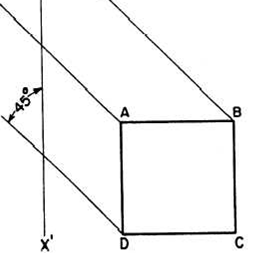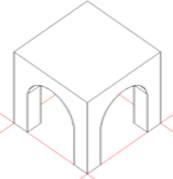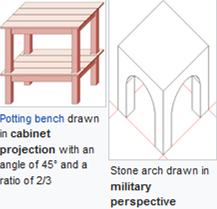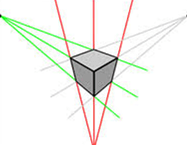This set of Civil Engineering Drawing Multiple Choice Questions & Answers (MCQs) focuses on “Oblique Projection”.
1. When the receding lines are true length, and the projectors are at 45 degrees to the plane of projection, the oblique drawing is called ______________
a) oblique projection
b) isometric projection
c) axonometric projection
d) cavalier projection
View Answer
Explanation: Cavalier projection is a form of oblique projection in which the projection lines are presumed to make a 45-degree vertical and a 45-degree horizontal angle with the plane of projection. Assume that in figure below the line XX’ represents a side-edge view of the plane of projection and that the square ABCD represents a side of a cube, placed with its front face parallel to, and its top face perpendicular to, the plane of projection. You can see that the projected lengths of AB and AD are the same as the actual lengths.

2. In oblique projections, the projectors are perpendicular to each other but are not parallel to the plane of projection.
a)True
b)False
View Answer
Explanation: Oblique projection is a type of parallel projection:
• It projects an image by intersecting parallel rays (projectors)
• From the three-dimensional source object with the drawing surface (projection plane).
In both oblique projection and orthographic projection, parallel lines of the source object produce parallel lines in the projected image. The projectors in oblique projection intersect the projection plane at an oblique angle to produce the projected image, as opposed to the perpendicular angle used in orthographic projection.
3. In general, all types of sections for isometric drawing may be applied to oblique drawing.
a) True
b) False
View Answer
Explanation: An isometric projection is a technical way of representing an object in three dimensions and may include several oblique views of the object. It’s used extensively in engineering and manufacturing to provide an accurate and detailed view of how an object is designed or put together, whereas an oblique view will always show the object as being perfectly flat with respect to the picture plane (I.e., that particular face of the object will have only two dimensions from the viewer’s point of view).
4. In oblique projections, one of the object’s principal faces is parallel to the plane of projection.
a) True
b) False
View Answer
Explanation: In both oblique projection and orthographic projection, parallel lines of the source object produce parallel lines in the projected image. The projectors in oblique projection intersect the projection plane at an oblique angle to produce the projected image, as opposed to the perpendicular angle used in orthographic projection.
5. Oblique sections are useful to show the _____________
a) interior shapes
b) oblique lines
c) foreshortened features
d) projected features
View Answer
Explanation: Oblique drawing is also the crudest “3D” drawing method but the easiest to master. One way to draw using an oblique view is to draw the side of the object you are looking at in two dimensions, i.e. flat, and then draw the other sides at an angle of 45°, but instead of drawing the sides full size they are only drawn with half the depth creating ‘forced depth’ – adding an element of realism to the object. Even with this ‘forced depth’, oblique drawings look very unconvincing to the eye. For this reason oblique is rarely used by professional designers and engineers.
6. The term __________ stems from its use in illustrations by the furniture industry.
a) cavalier projection
b) axonometric projection
c) cabinet projection
d) dimetric projection
View Answer
Explanation: The term cabinet projection (sometimes cabinet perspective) stems from its use in illustrations by the furniture industry. Like cavalier perspective, one face of the projected object is parallel to the viewing plane, and the third axis is projected as going off in an angle (typically 30° or 45° or arctan (2) = 63.4°). Unlike cavalier projection, where the third axis keeps its length, with cabinet projection the length of the receding lines is cut in half.
7. In _________a point of the object is represented by three coordinates, x, y and z.
a) axonometric projection
b) cavalier projection
c) cabinet projection
d) military projection
View Answer
Explanation: In cavalier projection (sometimes cavalier perspective or high view point) a point of the object is represented by three coordinates, x, y and z. On the drawing, it is represented by only two coordinates, x″ and y″. On the flat drawing, two axes, x and z on the figure, are perpendicular and the length on these axes are drawn with a 1:1 scale; it is thus similar to the dimetric projections, although it is not an axonometric projection, as the third axis, here y, is drawn in diagonal, making an arbitrary angle with the x″ axis, usually 30 or 45°. The length of the third axis is not scaled.
8. A variant of ___________ is called military projection.
a) 3- projection
b) Orthographic projection
c) Isometric projection
d) Oblique projection
View Answer
Explanation: A variant of oblique projection is called military projection. In this case the horizontal sections are isometrically drawn so that the floor plans are not distorted and the verticals are drawn at an angle. The military projection is given by rotation in the xy-plane and a vertical translation an amount z.
9. This figure below is a _____________ in oblique projection.

a) Military projection
b) 3- point projection
c) Isometric projection
d) Army projection
View Answer
Explanation: A variant of oblique projection is called military projection. In this case the horizontal sections are isometrically drawn so that the floor plans are not distorted and the verticals are drawn at an angle. The military projection is given by rotation in the xy-plane and a vertical translation an amount z.

10. The figure below represents _____________ point perspective.

a) 2
b) 3
c) 4
d) 5
View Answer
Explanation: The biggest difference in three-point perspective is that there are three vanishing points (VPs). Two are along the horizon, just like two-point, but the third VP is located either above the horizon (at the zenith) or below the horizon (the nadir), depending on the area you intend to draw.
Sanfoundry Global Education & Learning Series – Civil Engineering Drawing.
To practice all areas of Civil Engineering Drawing, here is complete set of 1000+ Multiple Choice Questions and Answers.
If you find a mistake in question / option / answer, kindly take a screenshot and email to [email protected]
- Apply for Civil Engineering Internship
- Check Civil Engineering Drawing Books
- Check Civil Engineering Books
- Practice Civil Engineering MCQs
